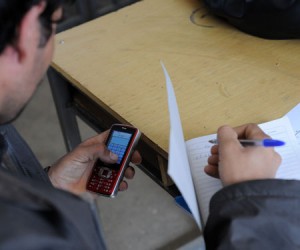By Katie Stansberry
I was in the middle of a lecture on blogging today when an all-too-familiar sound broke the flow of my presentation – the mechanical music of a ringing cell phone. To make the situation all the more annoying, the phone belonged to me. Despite my daily reminder to students to make sure their phones are silent, I’d forgotten to turn my own ringer off.
The wrath of teachers dealing with mobile technology is well documented. One YouTube video, which shows a professor grabbing a student’s ringing cell phone and smashing it into bits without breaking stride in his lecture, has received more than 4.5 million hits. Although I know many of my colleagues would disagree, I just cannot empathize with their cell phone frustrations. I also have never asked students not to use laptops during class and I fully expect students to email me more often than they come into my office hours.
The benefits of increased technology in the classroom far outweigh the tempting distractions that come along with laptops, iPads, Smartphones, and even video games. The problem is that, in general, our expectations of what constitutes appropriate education lags behind what is possible with new technologies.
If a teacher expects students to learn by memorizing raw facts and parroting responses, then there is no question that new technology could distract a class from that mission. However, if an instructor instead acts as a learning facilitator who empowers students to learn by showing them how to apply the wealth of information accessible through the web then classroom technology can be an integral part of the teaching process.


